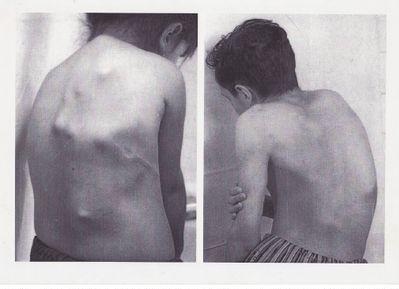What is torsion of the vertebrae, as it manifests itself and is diagnosed
Torsion (torsional deformation) of the vertebrae involves "twisting" (but not rotate) around the vertebrae posterior longitudinal ligament, "stretched" along the dorsal part of the axis of the spinal column. This condition is often observed in scoliosis (curvature of the spine axis in the side plane) and is characterized by a shift of legs arches of the vertebrae with violation of symmetry in the spinal segment (assessed by x-ray study). Often, the process occurs in the background of a wedge-shaped deformation of the vertebrae the disease of Chairman Mau in adolescents.

Often confused with the torsion rotation. Actually it is 2 different concepts. To understand what torsion we will consider the anatomical and physiological features of the structure and functioning of the spine.
In fact, in medical literature these terms are synonyms. Fundamentally this issue is not considered by scientists, because in both types of rotation of the vertebrae apply similar principles of treatment, and in the anatomical Atlas, there is no term "torsio", but is "rotacio".
does Not represent the interest of the state data and in evaluating the biomechanical characteristics of the spine, so the doctors "do not focus" on the specification of the characteristics of their diagnosis. In fairness, let's try to find the difference between torsion and rotation.
How is torsion of the vertebral body
Torsion occurs when the "twists" the body of the vertebra, but not multiple segments of the vertebral column.
The Main features of torsion:
- the Body of one vertebra is shifted relative to the posterior ligament of the spine in the normal position of neighboring segments;
- by visual inspection of the back external change is observed;
- Without compression nerve root pain syndrome was not observed even when twisting more than 90 degrees;
- In pictures when determining the degree of displacement of the body of the individual vertebra, the radiologist focuses on the shade of the arches. If they are symmetrical on both sides of torsion no. If instead of 2 of shadows of the roots of the arches in the picture is traced, only one has a rotation.

Indicator to the axis of rotation when the torsion is posterior longitudinal ligament of the spine, and not the apical vertebra, as in the rotation. Consequently, radiographs of the spine performed in a direct projection, for the diagnosis of pathology should be guided by a displacement of the vertebral bodies and irregular arrangement of their arches. More clearly these changes can be traced when performing magnetic resonance imaging. To determine the magnitude of the arc should focus on the roots of the arches.
More simple terms the torsion can be explained by the example of a matchbox. If you put it on the edge, twist the base and top in opposite directions, will receive a visual example of the torsional displacement (deformation). The body of the box means one of the functional spinal segment (consists of 2 vertebrae and the intervertebral disc between them).
A Rotation can be represented, if after a few matchboxes to pierce the needle, and slip this design like a vertical spiral staircase.
When diagnosing the above pathological conditions doctors determine the residual spread, which reflects the functional insufficiency of the vertebral column.
Residual reversal describes the angle of rotation of a vertebral body or a spinal segment (with rotation), which remains when returning to the axis of the spine to the normal position from the side rotate the torso.
Diagnosis of residual deformation:
- x-ray images Are corrupted Department in frontal and lateral projections;
- the First series is performed when turning the patient to one side;
- Second – when it returns to the normal position;
- the Difference between an angle when turning and in the normal position and is permanently deformed.
How to estimate torsional deformation during scoliosis

sultes Apparatus for measuring the torsion of the spine
The Most current evaluation of torsion deformation of vertebral bodies with scoliosis.
To assess twisting in such a situation the following methods:
- Sample Pevely. Is held in a standing position with straight legs and a straight back. In this pose makes the spine radiograph in direct projection. The displacement of individual vertebrae can be identified by the deviation of the spinous process of the vertebra is twisted from a vertical plane;
- Cobb Method. Involves the performance of radiography of the spine in lateral projection. The obtained picture is a line along the anterior or posterior parts of the vertebral bodies. Violation of smoothness at some level will be indicative of the torsion.
depending on the causative factor torsionclassified into:
- Absolute;
- Relative.
The Absolute torsion occurs against a background of spine diseases. Most often it occurs on the background of scoliosis (the offset of the axis in the lateral plane) and kyphoscoliosis (increased thoracic kyphosis and deviation of it at a certain angle to the side).
Pathogenesis in these diseases is the hyperextension of back muscles, the dysfunction of the intervertebral joints, making it impossible to return spinal segments under physiological position when turning the torso.
Functional torsion occurs when the asymmetric functioning of the skeletal muscles on both sides of the back or pressure on a certain part of the spine enlarged liver, or a distended bowel. In this situation, the spine is returned to normal operation after elimination of the main causes of the disease. Functional pathology may also occur in a period of rapid growth of the vertebral column (in adolescents).
Thus, torsion is the twisting of the deformed vertebra along an axis, which is the posterior ligament of the spine. Rotation – the rotation of the undeformed vertebrae along the vertical axis of the spinal column. Doctors use these terms interchangeably, which does not affect the tactics of treatment of disease.













